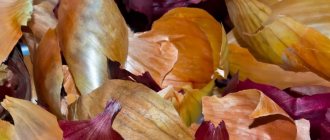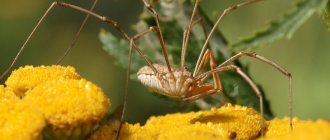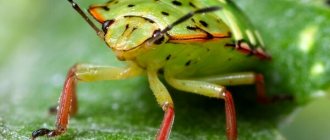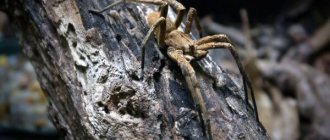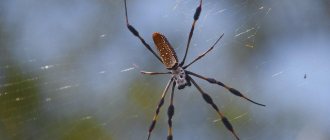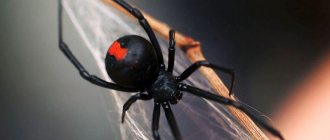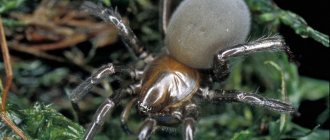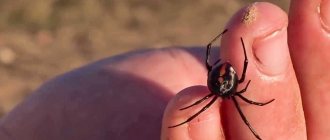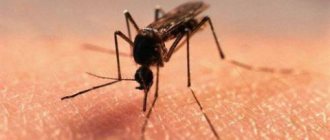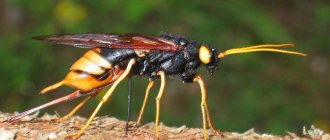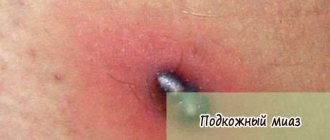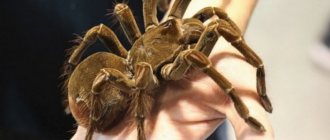The popular nicknames “haymaker”, “mow-hay” and “kosinozhka” are used by two different, although, at first glance, similar creatures. Such names arose from the fact that if you tear off an animal’s paw, it will begin to contract, reminiscent of the movement of a scythe in a hayfield. One of the owners of this name is indeed a spider and lives mainly right in a person’s home. The second one (we will call it in the article the pigtail) has only an appearance reminiscent of a spider, but in fact it is not a spider, and we meet it mainly on the street. In this article I will talk about the features of the haymaker spider, its differences from a simple haymaker (mower spider), and whether we should be afraid of such neighbors.
The haymaker spider and the pigtail spider - can they cause harm? © Paolo Beneventi
Harvesting spider - main features
The haymaker spider, or long-legged spider (Pholcidae), belongs to the spider family and has a small body length, from 2 to 10 millimeters. The length of the legs is usually much longer than the length of the body and in some species can reach 50 millimeters.
This spider has four pairs of long, thin legs. The knee segment is much darker than the main tone of the legs. The cephalothorax and abdomen are two clearly visible structures connected by a visible narrow tube. The head has eight eyes and poisonous, but very small fangs that are not even capable of holding prey. They are intended only for making bites.
The male spider has large palps. The color and size of such spiders can vary, but in the middle zone we are mainly dealing with small gray spiders. In place of the heart (in the upper abdomen) there is a dark spot.
The haymaker spider does not make a web of the traditional radial shape that is characteristic of many spiders. His buildings look untidy and disorderly. In fact, such chaos is the spider’s cunning idea. Its web does not have sticky properties, but, trying to get out, the insect becomes even more entangled in such chaotic structures as in a labyrinth. After which the spider begins to entangle its victim and delivers a fatal bite. He can immediately consume his prey for food, or store it for later.
In nature, such spiders usually set up their traps in caves, animal burrows, under stones and in trees. In human homes, the haymaker can be found near windows, or in corners under the ceiling, where it is difficult to reach while cleaning. As a rule, these spiders choose warm and dry places for their homes, but they can also live in toilets or bathrooms. It is also a traditional inhabitant of sheds, attics and cellars, which is why it is sometimes called the “cellar spider.” On their web, harvestmen usually hang upside down. If the fabric gets too dirty, they throw it away and weave a new house.
Haymaking spiders have another interesting feature - when they are greatly disturbed, they feel the threat of an attack, or their webs have caught too large and dangerous prey, they begin to vibrate strongly with their whole body, swinging their webs. This behavior is designed to scare off the enemy and become unnoticed against the backdrop of the shaking web. Because of this, they also received the nickname “vibrating spider”.
Haymaking spider or long-legged spider
Reproduction
At the end of summer, the mating season begins for the haymakers. They completely lack marriage rituals. Having met a sexually mature female, the spider quickly mates and goes about its business.
The female lays up to 50 eggs. She places them in a cocoon one at a time or in small piles under fallen leaves, in moss or simply in loose soil. She carries out this procedure using the ovipositor located in the lower part of the abdomen. The period between clutches ranges from several days to 3 weeks.
The eggs remain dormant throughout the winter. With the onset of spring, small spiders emerge from them, which immediately scatter in different directions. The young quickly adapt to the environment, and with the arrival of autumn they are already capable of giving birth to a new generation of hay spiders.
Video
https://youtube.com/watch?v=V5dg0qDNFNg
https://youtube.com/watch?v=I4FYefYtVnM
Harvesting Spider Menu
Harvesters eat almost all insects (flies, beetles, butterflies); in addition, they include other spiders (for example, the house spider), as well as ticks and even other individuals of their species in their menu. The spider lives in the house all year round. In winter, when there are almost no insects left, the spider has to look for prey among its closest relatives.
Usually his prey is other individuals of harvesting spiders - when he is hungry, he has no other alternative. During seasons when the overall insect population is minimal, the spider begins to undertake “reconnaissance expeditions” around the house. As soon as a spider finds the web of its relative, it portrays itself as prey, swinging the web with its long legs. When the owner of the web runs out at the signal, the spider inflicts a fatal bite on him.
Unlike most other spiders, harvest spiders breed year-round. Once the male is ready to mate, he goes in search of a female. When he finds a bride, he immediately lets her know about his “noble intentions.” This also occurs in the form of vibration with the whole body on its web. As the female approaches, the male strokes her first pair of legs, which quickly wins the favor of his future wife.
If mating goes smoothly, the male is usually not eaten by the female, but remains next to her until he dies a natural death. The male harvester lives only one year, while the female lives 3 times longer.
Young spiderlings are transparent and have short legs. Even after several molts, the spiders remain with their mother, and she carries them between her jaws. Growing up spiderlings practice catching tactics with their brothers and sisters, eventually leaving their mother and starting to live on their own.
Harvesters eat almost all insects. © Classiccardinal
Special Features
If you grab a haymaker's leg, it will easily come off. For a few more minutes, the severed limb will make convulsive movements.
The ease with which the limb comes off creates the misleading impression that the legs are loosely attached to the body. In fact, this is not true. The harvester deliberately separates the limb. The paw comes off like a lizard's tail. This autotomy helps the haymakers to escape from enemies.
We suggest you familiarize yourself with How to wash the inside of a bottle of greens: simple and quick methods
The predator first stumbles upon the paws, and then is distracted by the moving limb while the animal flees. Therefore, you can often find individuals who have an incomplete number of legs.
Is the haymaker spider dangerous for humans?
I don’t know who invented the myth about the terrible poisonousness of this tiny spider. Perhaps such a horror story was invented by children who love to scare each other. Of course, this spider also has venom glands, but the degree of its poisonousness to humans is not even considered, since its tiny fangs are not capable of cutting through human skin. Moreover, they are so small that spiders select only the most tender parts of the victim to bite.
Can these long-legged neighbors help us? Haymaking spiders have a very varied menu. In short, they can catch almost every insect that comes into your home, including flies and mosquitoes. If such a spider settles near a window, then its web will also catch insect pests that damage seedlings and indoor flowers. Thus, these spiders regulate the population of insects, including harmful ones, and other spiders in the house.
The web of this spider does not have the traditional intimidating appearance, and in some places, in principle, you can put up with it if you perceive this spider as an assistant in the fight against unwanted insects and other spiders. In addition, this subtle “translucent” spider does not have a completely intimidating appearance, like, say, a house spider. Even people who are afraid of spiders can be relatively calm about the harvestman. This means that, judging by the totality of its features, the haymaker spider is not the worst neighbor.
Getting rid of it using chemicals
You can also fight spiders with chemicals. “Butox-50” has proven itself well, which needs to be sprayed in places where such insects are most concentrated, close the doors tightly and leave for about 20 minutes. After treatment, the room needs to be ventilated and wet cleaned. The drug "Neoron" is effective, the use of which is contraindicated in the kitchen to avoid its contact with food and utensils. You can destroy spiders using Tarax, which when sprayed creates a film of the active substance. Spiders die almost immediately upon contact with it. It is enough to treat their locations with a spray bottle.
You can place special dry trap tablets in the corners, the smell of which attracts arachnids, and the poison they contain kills.
Differences between the moss spider and the haymaker spider
Another haymaker (Opiliones) - the mosstail - belongs to the order of arthropods from the class of arachnids, but is not a spider. This creature usually does not live in human homes, but we often see it in gardens and vegetable gardens. In some countries, such a harvester is also often called a “harvester”, since they are most often observed in the fall during harvesting.
Unlike the harvest spider, this arthropod has a uniform oval fused body, whereas in spiders it consists of two noticeable segments. The legs of the harvestman have an extraordinary length in relation to the body and can even reach 16 centimeters with a body size of 1-5 millimeters. The color is usually gray, brown or black.
Unlike eight-eyed spiders, they usually have one pair of eyes. In addition, harvestmen do not weave webs and do not have poison. But they have glands that secrete a secretion with a sharp unpleasant odor, due to which they are rarely eaten by animals or birds.
Harvesters are omnivores, they eat insects, spiders, ticks, slugs, snails and plant material, and can also feed on particles of manure. These animals are scavengers, but can also behave as predators. At the same time, they feed not only on the liquid internal contents, like spiders, but also eat the solid parts of the prey.
Kosinozhki lose one of their limbs not only as a result of cruel childhood games. Often, when attacked, harvesters independently throw their leg away from their body in order to distract a potential predator. For some time (up to half an hour) after separation, the limb will twitch. This twitching, reminiscent of the work of a scythe, probably distracts the attention of predators and allows the harvester to escape. Unfortunately, a lost leg cannot be replaced, but the animal often adapts to its absence.
Another defense mechanism exhibited by some species is hopping. The braids rapidly vibrate the entire body, which can distract or frighten the predator. In addition, harvestmen sometimes gather in large groups that look like hairy furballs due to the many long, thin legs, with the haymakers interlocking with their legs. The creation of such clusters provides the arthropods with warmth and humidity, as they quickly become dehydrated, and can also confuse predators.
Braided leg. © Chris Stringfellow
origin of name
The arthropod's paws are easily torn off, and the damaged area quickly heals without causing harm. The leg continues for some time to make movements that resemble a scythe during haymaking. This is where the name comes from: goat's leg, haymaker, spider's leg, goat's leg
The paw attracts the enemy's attention while the spider runs away. Natural enemies are other arachnids and birds. The Latin name opiliones literally means "shepherd"
The associations arose due to the long legs resembling stilts. In ancient times, shepherds often used stilts to make it easier to keep track of their flock. An American writer named the spider opiliones due to its massive distribution in pastures.
A tick is also called a haymaker, which has nothing in common with an arachnid. According to genetic studies, the pigtail's DNA is more similar to scorpions than to spiders.
How are mowers useful in the garden?
Mainly, harvesters go hunting at night, looking for small insects, eggs or decaying plant or animal remains on the ground or on plants. Their food preferences include ants, mosquitoes, caterpillars, slugs, and snails. Agree, these are not the most pleasant guests of our garden. In addition, sourbugs readily destroy the eggs of various pests.
Haymakers, as scavengers, are garden orderlies, processing various organic waste. Thus, the arthropod harvester is our assistant on the site. And if you meet such a creature resting in the midday heat, then you need to leave it alone. And even more so, you shouldn’t be afraid of him!
Habitat and lifestyle
Being tropical spiders by origin, representatives of the species are able to remain active throughout the year. Their clutches with future offspring can be found in domestic premises even in the depths of winter. In nature, grasshoppers are distributed almost everywhere, but prefer forest areas in temperate and southern climates.
This small predator hunts using a method of its own invention - due to the absence of glands that secrete adhesive substances, the network is woven in a chaotic manner. Outwardly untidy clusters of threads can be quite effective, as potential food begins to panic and wraps itself more and more securely in a dense network.
Representatives of the species are nocturnal hunters, using their long legs to quickly find themselves near a prey entangled in a web. At dusk, the spider freezes with its head down, touching the signal thread of the web with its paw.
When any insect gets into the net, the harvester immediately appears nearby and throws several additional threads, after which it bites the victim, injecting its juices. These spiders spend the daytime sedentary, spreading their legs on a wall, tree or other suitable place.
Most species are nocturnal predators. During the day they freeze in secluded places. Pets are hiding in the corners. Sometimes they can be seen frozen on the walls. A timid animal that immediately tries to hide when encountered.
Like all predators, they feed on animal food. The diet includes caterpillars, ants, mosquitoes, and various beetles. There are species that easily cope with snails. Some moss moths eat mushrooms, moss and other plant foods.
The structure of the oral apparatus allows it to absorb solid particles of prey. Food is crushed by pidipalps, which act as jaws.
Mythbusting
There is such a program - “MythBusters” with Jamie Hyneman and Adam Savage, they tested the statement about whether the bite of a haymaker spider is poisonous to humans.
The tests were carried out on Savage's hand, after which Adam said that he did not feel anything other than a slight burning sensation. Having further studied the composition of the poison, the researchers found that centipedes are less dangerous than, for example, the notorious “black widow”.
These creatures most likely do not have enough physical muscle strength and technical ability to bite a person, poisoning him. In addition, the venom of the harvest spider is fatal only to its prey; the bite does not cause harm to humans. This conclusion was reached by scientists who conducted tests in laboratory conditions, injecting poison into animals and studying their reaction.
In practice, not a single case has yet been registered in which a spider has bitten a person with dire consequences. Therefore, so far any claim that their poison is especially dangerous for you and me has not been proven.
But brown recluse spiders are poisonous creatures and are capable of biting people, and similar cases have been recorded.
However, scientists will likely continue their research and study of harvestmen.
Classification
Systematics divides these creatures into four main suborders.
Cyphophthalmi
A small suborder containing about 220 genera. These are primitive harvesters, whose fossil remains are found by paleontologists in Carboniferous deposits.
Representatives of this suborder have an oval oblong body, no more than 2 mm long. The legs are short. They live in the tropics and subtropical regions of Africa, South America and Eurasia.
The suborder includes two large families - Sironidae and Stylocellidae.
Eupnoi
This suborder includes the pigtails with the longest limbs. They have large eyes, a soft belly and special vitality.
They easily tolerate cold, being active until the first frost. Due to their special frost resistance, they settled throughout the planet. They are found on mountain slopes, deciduous and coniferous forests.
The suborder has 1,800 species, united in two families - Phalangiidae and Caddidae.
Dyspnoi
The most ancient representative of this suborder, Ameticos scolos, was discovered in coal deposits in France. Now it includes 320 modern species.
Very motionless species that sometimes seem lifeless. They live in the southern regions of Russia, in the vast expanses of Europe and Southeast Asia.
The legs are short. There are species that have an elastic abdomen, but there are also armored coverings. The suborder includes four families - Ischyropsalidae, Nemastomatidae, Trogulidae, Dicranolasmatidae.
Laniatores
The most numerous tropical suborder. Includes more than 4 thousand species. It is also the most mysterious, as it is the least studied.
Representatives of the suborder have a brightly colored body with a very hard protective covering. The abdomen is characterized by small bumpy growths. The settlement area is extensive. Found in the tropics of Africa, South America, and Australia.
A large population lives in India. The largest suborder includes five families - Cosmetidae, Gonyleptidae, Triaenonychidae, Oncopodidae, Phalangodidae.
Types of harvestmen
There are many types of braids in the world. Some of them are widespread, others are much less common, and only specialists know about the existence of others. Among the most famous representatives of haymakers:
- Pholcus phalangioides - individuals with a body size of 6 - 8 mm are distinguished by very long legs, the length of which can exceed 50 mm; in appearance they are very similar to the common harvestman;
- Crossopriza lyoni is a synanthropic species, found everywhere, does not bite and generally tries to remain unnoticed;
- Physocyclus globosus is a brown spider with a black stripe running along the cephalothorax and abdomen, lives in warm areas, lives mainly in caves;
- Smeringopus pallidus - spiders with an elongated abdomen are often found in houses or near them in garden areas.
